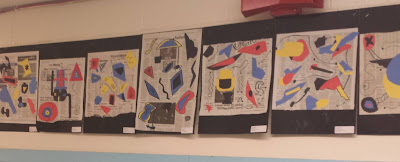 |
| Bob McLeod |
Superheroes like Superman were born with superpowers. Others become superheroes after pursuing other careers and eventually being bitten by a bug like Spiderman. Such superpowers simply developed later in life. Often, the careers we choose or have been chosen for us don't align well with our hidden talents. We may dabble in art as a hobby at first, then with encouragement and training, it turns into a profession, if we're lucky.
I've been doing art all my life. In college, I thought I'd combine art and science and study Architecture. I made it through the first year and a half, then decided to switch to Mechanical Engineering. My technical elective became minicomputers. My career eventually morphed into Software Engineering. It turns out that my superpower was computer programming, a creative endeavor that combines design and coding.
I only recently discovered the Superhero metaphor after watching the Quentin Tarantino Kill Bill movies. During Volume 2, Bill (David Carradine) tries to tell Beatrix Kiddo (Uma Thurman) that she is a natural-born killer. He uses Superman as someone who was an actual superhero, living disguised as a journalist, Clark Kent. He goes on to describe Spiderman as a costume that newspaper photographer, Peter Parker wears as a disguise. To Bill, Kiddo is the real thing and can't escape it; motherhood is only a costume. This got me thinking about famous visual artists whose talents were discovered early and encouraged versus those who took up art as a career later in life.
I found that ~70% of the 25 artists I researched follow the Superman metaphor. The other 30% didn't get bitten by the bug to find their Spidey-Senses until later in life. I maintain that our talents need to be recognized, guided, and encouraged in order to develop. This happens through opportunity, parental encouragement, strong influences, exploration, persistence, trial and error, and sometimes our own internal struggles.
 It's the same for Superman and Batman. Bruce Wayne loses both parents early in life and struggles for vengeance as Batman. His desire to thwart evil and a privileged lifestyle affords him an opportunity to use his wealth for good and channel his loss into something positive.
It's the same for Superman and Batman. Bruce Wayne loses both parents early in life and struggles for vengeance as Batman. His desire to thwart evil and a privileged lifestyle affords him an opportunity to use his wealth for good and channel his loss into something positive.Superman loses both parents before coming to Earth and being adopted by Jonathan and Martha Kent. Unlike Batman, Superman only wants to fit in but needs to find a way to adapt his superpowers to life on his new planet. Some artists lost siblings or parents early in life and learned to express themselves through art.
 The reason we call them Superheros is because of their ability to overcome adversity. For example, Jackson Pollock was adopted following the death of his birth parents just one year apart. His struggles not only produced a great body of abstract work, but his alcoholism led to the fatal car crash that ended his life at 44. A tragic example of a struggling artist!
The reason we call them Superheros is because of their ability to overcome adversity. For example, Jackson Pollock was adopted following the death of his birth parents just one year apart. His struggles not only produced a great body of abstract work, but his alcoholism led to the fatal car crash that ended his life at 44. A tragic example of a struggling artist! Salvador Dali's older brother (also named Salvador) died 9 months prior to his own birth, which haunted him for the rest of his life. That must have led to some crazy dreams!!
The Superman Group
Spanish Surrealists Salvador Dali and Joan Miró, French Impressionists Edgar Degas, Édouard Manet, and Claude Monet, Jean-François Millet, Pablo Picasso, Diego Rivera, John Singer Sargent, Andrew Wyeth, Newell Convers Wyeth, and Georgia O'Keefe all began their careers as artists, many enrolled in art schools as pre-teens and teenagers. Many came from comfortably well-off, wealthy, or affluent families. Franz Marc, whose Father was a professional landscape painter, abandoned his study of Theology to study art at age 19. Impressionist Camille Pissarro worked as a cargo clerk, then became a professional artist at 21 (on the cusp of a Spidey). Frida Kahlo was a stenographer and engraving apprentice, bound for medical school until a bus accident at the age of 18 caused her to turn her childhood art hobby into a profession. Edward Hopper was a part-time illustrator for an ad agency before turning to full-time painting. Johannes Vermeer was an innkeeper and art dealer who became a great painter while fathering 10 children. The mother of his children must have been a real Wonder Woman!
The Spiderman Group
Jackson Pollock was expelled from several art high schools as a teenager and didn't really develop his art until the age of 24. Vincent Van Gogh was an Art Dealer, Supply Teacher, and Minister's Assistant who wanted to be in the Clergy. At 27, he became ill and began to paint, only to die at age 36. Mechanical Engineer, Alexander Calder was 28 before enrolling in art school, although he came from a family of sculptors. Wassily Kandinsky was a law professor before turning to art at age 30. Henri Rousseau also studied Law and became a tax collector before abandoning his career in his late 40s to paint. Other artists who began studying painting in their late 20s are Pierre-Auguste Renoir who sang in a choir, then apprenticed at a porcelain factory, and Mark Rothko who worked as a labor organizer at first. All of these artists are truly superheroes regardless of my contrived metaphor! It's still fun to learn about their artistic life journeys.


















































